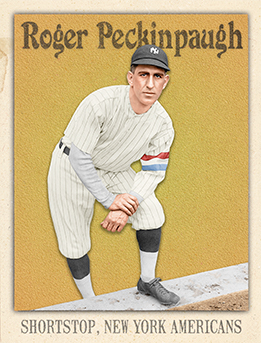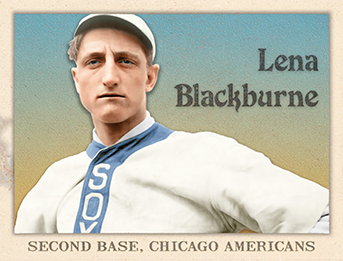
- Series: Diamond Heads '15
- City: New York
- Team: Yankees
- League: American League
Roger Thorpe Peckinpaugh (1891-1977) caught the eye of Nap Lajoie who signed the 19-year old to a pro contract in 1911 with Cleveland. The Naps quickly regretted sending the budding star to the Yankees in 1913, where Roger immediately impressed with his defensive skills at short (best arm of his era) and leadership qualities. Frank Chance made him captain the following year and, upon Chance’s resignation late in the season, Peckinpaugh became the youngest manager in MLB history. NY hired another to manage in ‘15, but Roger would remain captain his entire tenure with the Yankees, which culminated in a World Series appearance in 1921. That proved a fateful Fall Classic for the veteran shortstop. He set a record with nine assists in one game, but his failure to corral a first-inning grounder in the deciding game allowed the only run to score. Peckinpaugh would be traded to Boston that offseason. Far from through, Roger would win a Series with the Senators in ‘24 and then play the goat once more as Washington dropped the 1925 Series. He was honored that year as the first SS named MVP. The League Awards had replaced the Chalmers Award in 1922.
- Became Cleveland’s manager in 1927, returned in ‘41 and later stepped up to GM

- Series: Diamond Heads '15
- City: St. Louis
- Team: Terriers
- League: American League, Federal League
- Hall: Cuban Baseball Hall of Fame
Armando Marsans (1887-1960) was the first Cuban to make a real impact in the major leagues. Frank Bancroft had spotted Marsans and Rafael Almeida in exhibition games in 1905 and finally brought them to Cincinnati in 1911. In his sophomore season with the Reds, Marsans hit .318 with 35 stolen bases and only 17 strikeouts in 448 plate appearances, placing a respectable 18th in Chalmer’s Award voting for 1912. A row with fiery manager Buck Herzog resulted in Marsans seeking a job with the new Federal League’s St. Louis Terriers in ‘14. When the league folded, Marsans signed on with the Browns but inactivity took a toll. Two years with the Yankees ended his MLB career in 1918 but Armando had many more years of baseball left. He continued to play winter ball back home through the 1928 season and became the first to play in the majors and the Negro Leagues in 1923 with the Cuban Stars. Marsans thrived as a manager in both Cuba and the States (another first for his countrymen), finally retiring in 1947 after 43 years in baseball.
- The blue-blood Marsans was well-educated and an entrepreneur as well as a savvy baseball mind. Nevertheless, the Reds fended off race-baiting accusations in 1911
- Artist’s Note: Images of Marsans are fairly rare and it is not uncommon for me to take liberties with dates and uniforms. This photo was taken in 1916 when Marsans was with the St. Louis Browns. In anticipation of the feedback I will receive, I’d like to invite you to join me in pretending this is a St. Louis Terriers’ uniform. Cheers!
- Elected to Cuban Baseball Hall of Fame in its inaugural class: 1939

- Series: Diamond Heads '15
- City: Washington, D.C.
- Team: Senators
- League: American League
Herman A. Schaefer (1876-1919) was the Clown Prince of baseball for nearly two decades in the early years of the last century. “Germany” (or “Liberty” as he thought a better nickname after WWI began) was beloved for his antics on the field. In its obituary, the New York Times said he was “one of the most popular figures on the diamond.” Born into the tough German immigrant district of south Chicago, the stocky Schaefer came up through semi-pro ball and soon made it to the Cubs in late 1901. A slump the following year sent him to the PCL and other minor league teams before the Tigers brought him back to the bigs in '05. Legends surrounded the colorful Schaefer and it is hard to tell fact from fiction. He was said to have called shots long before the Babe, make dramatic self-narrated trips around the bases and harangue mercilessly some of the greats of his day. One of his most storied feats involved his famed steal of first, accomplished from second base in order to tempt a run-scoring errant throw. After his death, baseball officially outlawed such depredations. John McGraw hired Schaefer as a scout in 1919 but the bantam joker succumbed to a TB-induced hemorrhage on a train trip to check on NY talent.
- Germany played for six MLB teams including the Federal League's Newark Peppers. He closed his career with Cleveland months before his untimely death
- His lifetime .257 average belied his ability to deliver clutch hits, seemingly at will, when the moment was right
- A Detroit sportswriter effused: “Germany Schaefer was the soul of baseball itself, with all its sorrows and joys, the born troubadour of the game.”
- Series: Diamond Heads '15
- City: Detroit
- Team: Tigers
- League: American League
- Hall: National Baseball Hall of Fame
Samuel Earl Crawford (1880-1968) needed a couple more weeks among his 19 ML seasons to reach 3000 hits, finishing with 2961 and the all-time record for triples. “Wahoo Sam” teamed with Ty Cobb for 3 straight Series appearances ‘07-09. Neither did well or won a title. Nevertheless, the renowned manager who made Babe Ruth an outfielder said there was never a better hitter than Crawford. This Nebraska farm kid was considered the strongest hitter of his day and consistently ranked in the top 10 in slugging.
- Playing in the big Deadball Era parks, speedy Crawford set the record for inside-the-park HRs
- Debuting with Cincinnati in 1899, Crawford hit .307 as the youngest player in the majors
- A model of moderation, he rarely struck out, walked or reacted to teammate Cobb’s tirades
- Elected to Hall of Fame: 1957

- Series: Diamond Heads '15
- City: Chicago
- Team: White Sox
- League: American League
Russell Aubrey Blackburne (1886-1968) was no great shakes as a player and had a sub-.500 career as a manager. Not many with a lifetime .214 average get mentioned at Cooperstown. But Lena had a bulldog spirit and a zeal to improve one key aspect of baseball: the sheen on the balls themselves. Until Blackburne’s “Rubbing Mud,” balls were doctored with tobacco juice, Shinola, and whatever the local swamps provided, all in an attempt to take some of the manufacturer’s shine off the spheres. Lena found a solution that still serves the game today. True to his discoverer’s spirit, he kept secret the source of the clay from which he made the rubbing compound. It was believed to be a spot on the Delaware River near his home. Blackburne had played for the White Sox, Reds, Braves, and Phillies before coaching and managing for the Sox, Browns and Athletics. He was enough of an AL-partisan to restrict use of his wonder-mud to the American League until the mid-1950s when the NL at last could partake.
- No other compound improved the grip on the ball without damage to the horsehide
- No one has gotten rich from the Mud. Team’s can get by with one 32-oz container per season at a cost of about $60. The current vendor of Blackburne’s concoction has to work full-time to support his family




